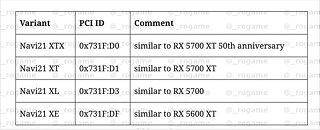- Joined
- Oct 9, 2007
- Messages
- 47,294 (7.53/day)
- Location
- Hyderabad, India
| System Name | RBMK-1000 |
|---|---|
| Processor | AMD Ryzen 7 5700G |
| Motherboard | ASUS ROG Strix B450-E Gaming |
| Cooling | DeepCool Gammax L240 V2 |
| Memory | 2x 8GB G.Skill Sniper X |
| Video Card(s) | Palit GeForce RTX 2080 SUPER GameRock |
| Storage | Western Digital Black NVMe 512GB |
| Display(s) | BenQ 1440p 60 Hz 27-inch |
| Case | Corsair Carbide 100R |
| Audio Device(s) | ASUS SupremeFX S1220A |
| Power Supply | Cooler Master MWE Gold 650W |
| Mouse | ASUS ROG Strix Impact |
| Keyboard | Gamdias Hermes E2 |
| Software | Windows 11 Pro |
AMD's RDNA2 graphics architecture, which sees real-time ray-tracing among other DirectX 12 Ultimate features, could see the company double the amount of stream processors generation-over-generation, according to a specs leak by _rogame. The increase in stream processors would fall in line with AMD's effort to increase performance/Watt by 50%. It may appear like the resulting SKUs finally measure up to the likes of the RTX 2080 Ti, but AMD has GeForce "Ampere" in its competitive calculus, and should the recent specs reveal hold up, the new "Navi 21" could end up being a performance-segment competitor to GeForce graphics cards based on the "GA104" ("TU104" successor), rather than a flagship-killer.
The RDNA2-based "Navi 21" GPU allegedly features 80 RDNA2 compute units amounting to 5,120 stream processors. AMD might tap into a refined 7 nm-class silicon fabrication node by TSMC to build these chips, either N7P or N7+. The die-size could measure up to 505 mm², and AMD could aim for a 50% performance/Watt gain over the "Navi 10." AMD could carve out as many as 10 SKUs out of the "Navi 21," but only three are relevant to the gamers. The SKU with the PCI device ID "0x731F: D1" succeeds the RX 5700 XT. The one bearing "0x731F: D3" succeeds the RX 5700, with a variant name "Navi 21 XL." The "Navi 21 XE" variant has a PCI ID of "0x731F: DF," and succeeds the RX 5600 XT.

Among the other variants are the "Navi 21 XTX," with PCI ID "0x731F: D0," which could be a limited edition SKU succeeding the slightly beefed up RX 5700 XT 50th Anniversary Edition; the Navi 21 Pro XT and Navi 21 Pro XL with PCI IDs "0x731F:10" and "0x731F:12," marking Radeon Pro W5700X and W5700 successors, respectively. There are also four Apple-exclusive SKUs, the "Navi 21 XTA" and "Navi 21 XLA" client-segment chips targeting next-generation iMac and iMac Pro desktops, and their Pro variants targeting future Mac Pro workstations.
The first-gen RDNA may not ride into the sunset, as AMD is planning to refresh them. The company is probably porting the "Navi 10" silicon to TSMC N7P, to come up with new mainstream SKUs that lack ray-tracing, but will occupy mid-range price-points. This would be similar to NVIDIA positioning half its "Turing" product-stack without ray-tracing, under the GTX 16-series, occupying sub-$300 price-points. The resulting ASICs are the "Navi 10+," "Navi 10 XM+," and "Navi 10 XTE+."
View at TechPowerUp Main Site
The RDNA2-based "Navi 21" GPU allegedly features 80 RDNA2 compute units amounting to 5,120 stream processors. AMD might tap into a refined 7 nm-class silicon fabrication node by TSMC to build these chips, either N7P or N7+. The die-size could measure up to 505 mm², and AMD could aim for a 50% performance/Watt gain over the "Navi 10." AMD could carve out as many as 10 SKUs out of the "Navi 21," but only three are relevant to the gamers. The SKU with the PCI device ID "0x731F: D1" succeeds the RX 5700 XT. The one bearing "0x731F: D3" succeeds the RX 5700, with a variant name "Navi 21 XL." The "Navi 21 XE" variant has a PCI ID of "0x731F: DF," and succeeds the RX 5600 XT.

Among the other variants are the "Navi 21 XTX," with PCI ID "0x731F: D0," which could be a limited edition SKU succeeding the slightly beefed up RX 5700 XT 50th Anniversary Edition; the Navi 21 Pro XT and Navi 21 Pro XL with PCI IDs "0x731F:10" and "0x731F:12," marking Radeon Pro W5700X and W5700 successors, respectively. There are also four Apple-exclusive SKUs, the "Navi 21 XTA" and "Navi 21 XLA" client-segment chips targeting next-generation iMac and iMac Pro desktops, and their Pro variants targeting future Mac Pro workstations.
The first-gen RDNA may not ride into the sunset, as AMD is planning to refresh them. The company is probably porting the "Navi 10" silicon to TSMC N7P, to come up with new mainstream SKUs that lack ray-tracing, but will occupy mid-range price-points. This would be similar to NVIDIA positioning half its "Turing" product-stack without ray-tracing, under the GTX 16-series, occupying sub-$300 price-points. The resulting ASICs are the "Navi 10+," "Navi 10 XM+," and "Navi 10 XTE+."
View at TechPowerUp Main Site


 “ in this OP. Maybe that’s a good sign for the future.
“ in this OP. Maybe that’s a good sign for the future.





